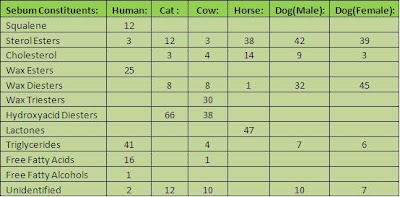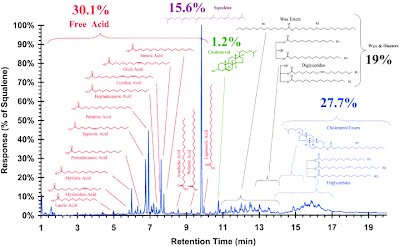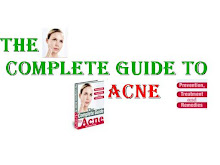 What is Sebum?
What is Sebum?Sebum is an oily substance produced and secreted on the surface of the skin by the sebaceous glands in the skin of mammals.
Function of the Sebum:
1) When sebum reaches the skin surface through the follicular canal it mixes with other lipids and sweats and forms a coating on the skin called as Acid Mantle. Acid mantle protects the skin against bacterial and fungal infections.
2) Sebum lubricates the skin to protect against friction and controls moisture loss from the epidermis.
Composition of Sebum:
 The above chart helps us to compare the composition of sebum in different species. The variation in the relative quantity of sebum in different species is due to the origin of the sebaceous glands. The human sebum is composed of
The above chart helps us to compare the composition of sebum in different species. The variation in the relative quantity of sebum in different species is due to the origin of the sebaceous glands. The human sebum is composed of1) 12% Squalene
2) 03% Sterol Esters
3) 25% Wax Esters
4) 41% Triglycerides
5) 16% Free Fatty Acids
6) 01% Free Fatty Alcohol
7) 02% Unidentified Components
 The above diagram shows the relative composition of human sebum when analyzed by Gas Chromatography. When sebum is secreted on the surface of the skin, it primarily consists of Triglycerides and Esters, which are broken down by microbes into Diglycerides, Monoglycerides, and the constituent Free Fatty Acids. Human sebum contains both saturated and unsaturated fatty acids, with a preponderance of unsaturates.
The above diagram shows the relative composition of human sebum when analyzed by Gas Chromatography. When sebum is secreted on the surface of the skin, it primarily consists of Triglycerides and Esters, which are broken down by microbes into Diglycerides, Monoglycerides, and the constituent Free Fatty Acids. Human sebum contains both saturated and unsaturated fatty acids, with a preponderance of unsaturates.Quantity of Sebum Production:
 Sebum is continuously produced by the sebaceous glands. The quantity of Sebum production depends upon the structure, activity and distribution of the sebaceous glands in the dermis. These glands are bigger, larger and more numerous on the face and the upper back. Hence, the quantity of sebum produced is more on the face in comparison to the other body parts.
Sebum is continuously produced by the sebaceous glands. The quantity of Sebum production depends upon the structure, activity and distribution of the sebaceous glands in the dermis. These glands are bigger, larger and more numerous on the face and the upper back. Hence, the quantity of sebum produced is more on the face in comparison to the other body parts.Factors Affecting the Quantity of Sebum Production:
1) Age:
Sebum secretion is very high at birth and decreases during pre-puberty. Then it suddenly increases at the time of puberty due to the activation of sex hormones. Sebum production decreases with age in both men and women. In women, sebum reduces substantially after menopause. Adult females produce less sebum than men.
2) Hormonal Factors:
Sebaceous secretion depends upon the hormonal levels. During puberty the fluctuation in the Androgen hormone level leads to excessive secretion of sebum which results in the imperfection and changes of the skin from normal to oily. This is the main reason that 90% of the teenagers suffer from acne during adolescence.
3) Nervous State:
Mental stress and lack of sleep can increase sebum production.
4) Pollution and Chemical Aggressions:
Atmospheric pollutions and chemical agents like detergents can also increase the production of sebum.
5) Heat and Humidity:
A high degree of humidity combined with high temperatures favous a greater production of sebum.
1) Age:
Sebum secretion is very high at birth and decreases during pre-puberty. Then it suddenly increases at the time of puberty due to the activation of sex hormones. Sebum production decreases with age in both men and women. In women, sebum reduces substantially after menopause. Adult females produce less sebum than men.
2) Hormonal Factors:
Sebaceous secretion depends upon the hormonal levels. During puberty the fluctuation in the Androgen hormone level leads to excessive secretion of sebum which results in the imperfection and changes of the skin from normal to oily. This is the main reason that 90% of the teenagers suffer from acne during adolescence.
3) Nervous State:
Mental stress and lack of sleep can increase sebum production.
4) Pollution and Chemical Aggressions:
Atmospheric pollutions and chemical agents like detergents can also increase the production of sebum.
5) Heat and Humidity:
A high degree of humidity combined with high temperatures favous a greater production of sebum.
Sebum and Acne:
Sebum is one of the main cause of acne. The sebaceous glands secretes sebum that drains into the follicular duct and eventually on the surface of the skin. The excessive production of sebum blocks the follicular pores. Due to the accumulation of sebum bacteria like Propionibacterium acne starts growing and hence leads to the formation of different types of acne. By reducing sebum production, acne can be treated. Sebum production can be controlled by various medicines - mainly vitamin A derivatives and birth control pills.
Due to the accumulation of sebum bacteria like Propionibacterium acne starts growing and hence leads to the formation of different types of acne. By reducing sebum production, acne can be treated. Sebum production can be controlled by various medicines - mainly vitamin A derivatives and birth control pills.
Sebum and Skin Odor:
Sebum itself is odorless but its bacterial disintegration produces odor. That is why if you keep your skin clean of bacteria with anti-bacterial soaps you can avoid body odor.
 Due to the accumulation of sebum bacteria like Propionibacterium acne starts growing and hence leads to the formation of different types of acne. By reducing sebum production, acne can be treated. Sebum production can be controlled by various medicines - mainly vitamin A derivatives and birth control pills.
Due to the accumulation of sebum bacteria like Propionibacterium acne starts growing and hence leads to the formation of different types of acne. By reducing sebum production, acne can be treated. Sebum production can be controlled by various medicines - mainly vitamin A derivatives and birth control pills.Sebum and Skin Odor:
Sebum itself is odorless but its bacterial disintegration produces odor. That is why if you keep your skin clean of bacteria with anti-bacterial soaps you can avoid body odor.

2 comments:
I honestly have done a lot of research, and I believe that there is actually a huge relationship between the foods that I've eaten and the acne that I had for so long. After going on a plant-based diet and cutting out excess sugar, I have been acne free for a year now and I no longer have to use acne face washes either. I've also taken Probiotics to replace the good bacteria that was destroyed after being on Antibiotics for so long. I don't really think this is a myth anymore. If nothing else, it needs more research. But, I always notice that if I begin to let my guard down and resort to poor eating, I begin to have problems with acne again. best acne treatment here
A friend suggested I try homeopathy but I've never tried it. She gave me a container of rhus toxicodendron with all the instructions written on the side. Can I take both at the same time? will it help? any advice appreciated. best acne treatment here
Post a Comment